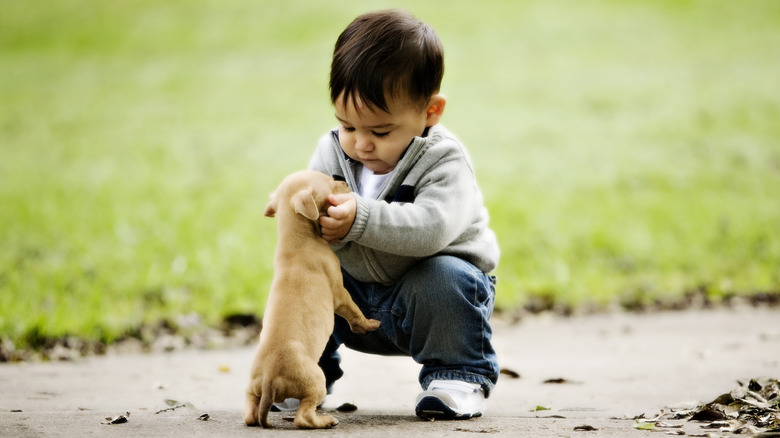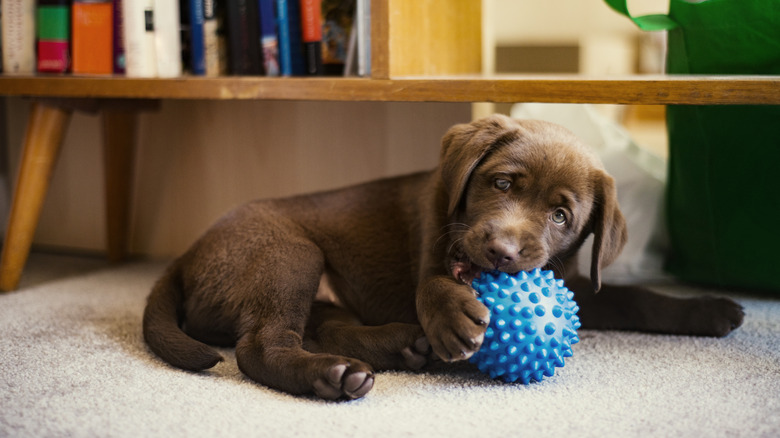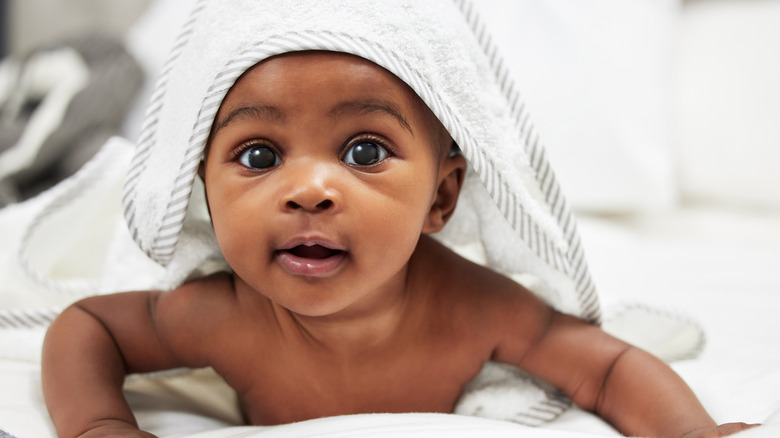What Happens To Your Body When You See Something Cute
Cute puppies. Cute babies. Cute kittens. If you love videos featuring cute subjects, your social media feed will give you more cute indulgences. The word "cute" stems from the word "acute," but it evolved to refer to a woman's physical attractiveness (per the Online Etymology Dictionary). Now cute refers to something adorable, and since 1980, cute has been on the rise.
YouTube influencer Vsauce says that cute reminds us of our offspring, so we instinctively want to nurture it. This nurturing feeling also corresponds to other little things, like little bunnies wearing a miniature backpack. When you see something cute, it activates a pleasure center of your brain called the nucleus accumbens. Your brain then releases that feel-good dopamine neurotransmitter.
That hit of dopamine can be a powerful force, according to The Conversation. Cute objects like babies can seize our attention, particularly if they have round faces and eyes. Cute comes front and center of our awareness. As a result, cuteness can also be very persuasive, but it also can make us a little paradoxically aggressive.
Your primordial response to cuteness
Your brain is hard-wired to respond to something cute without thinking. According to a 2016 article in Trends in Cognitive Sciences, seeing something cute activates what's called "kindchenschema" (infant schema) in your brain, and that brings forth a host of survival instincts to protect the young and perpetuate the species.
Whether you're a parent or not, brain scans show that a baby's face elicits a response within 140 milliseconds. This quick activity in your orbitofrontal cortex alerts you to important things and prepares you for action and social interaction. This can cause you to spring into action without much deliberation because of your instinct for caregiving. (Read how owning a pet affects your body.)
This cuteness response isn't limited to babies. People rate puppies and kittens to be just as cute as babies. Teddy bears and even Mickey Mouse have evolved over decades to possess baby-like features. You might continually choose cute objects to activate the reward system in your brain. Cute also activates your sense of empathy, as seen in pictures and videos of children or small animals subjected to harm.
Cuteness makes you more moral
Nonprofit organizations use cute images to help fund their campaigns. For example, St. Jude's Children's Research Hospital shows videos and testimonies of cute children to activate the cute emotional response. According to a 2023 study in the Journal of Pacific Rim Psychology, cuteness can influence your behavior. Seeing cute people or objects triggers your morality, so you're more likely to engage in prosocial behavior such as giving to charity. Researchers believe that seeing something cute makes you think about love, warmth, and happiness, so this cues you towards choices that align with these feelings. (Here's why joy is critical for your health.)
Cuteness also affects your moral judgments. The study showed either a cute picture or a neutral picture before reading a moral story. If people saw the cute picture, they judged immoral behavior more harshly. In other words, cuteness sets up an unconscious bias inside people that makes them favor moral thinking. Cuteness cultivates the good in you, but it also might elicit a strange sense of aggression.
When you want to squeeze or crush something cute
Something freaky can go on inside you when you see something cute. Ever want to squeeze, crush, or bite something cute? This is known as "cute aggression." It's not like you want to cause harm to something cute. Instead, it's a type of dimorphous expression, where you feel a paradoxical emotion when one emotion is particularly strong. It's a way for you to turn down positive emotions that can be overwhelming. In other words, you might be overwhelmed by the cuteness, but you don't know if you can take care of the cute object. So your brain responds by pulling back some of the overwhelm (per UNSW Sydney).
A 2018 article in Frontiers in Behavioral Neuroscience had people look at cute and less cute pictures of animals and babies while the researchers measured their brain activity. Viewing the cuter pictures stimulated emotions and activated the reward system of the brain. People also exhibited cute aggression for the cuter photos, saying things like, "I want to pinch those cheeks!" In addition, while they felt overwhelmed by positive emotions when seeing the cute photographs, they also wanted to take care of the objects in the photos.



